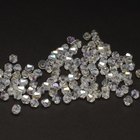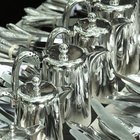Crystal salt lamps can originate in any country with the mines to produce them, including Russia, Poland, Iran, and of course, Nepal and Pakistan, two countries that border the Himalayas. Salt lamps generate negative ions, which purify the air and create a number of health benefits, and they generally aren't known for creating a hazard in your living room or bedroom. Nevertheless, certain dangers are inherent with the use of salt lamps that you should be aware of before you buy one.
Salt Lamps Can Break
The color of salt lamps ranges from deep red to white; white is the color of pure salt, and reddish hues are imparted by minerals -- mostly iron -- mixed in with the salt. Besides imparting color, minerals reinforce the salt crystals; without them, the crystals are brittle and can shatter. White salt lamps are often marketed as those with the purest vibrations, but beware -- they are also the most fragile.
Salt Is Corrosive
A salt lamp is a poor choice for placement in a high-humidity environment, such as the bathroom. Salt is hydroscopic, which means it absorbs water; as a lamp sweats, salt-laden water collects around the base and corrodes whatever surface the upon which the lamp is resting. If the surface is metal, it will quickly rust. That the salt attracts water is also a desirable feature, because it's this ability that creates beneficial negative ions. Most salt lamps come with a base -- you should never deploy a salt lamp without one, especially in the bathroom, kitchen or basement.
Salt Lamps Are Heavy
Salt lamps range in weight from 5 to over 50 pounds, and generally, the heavier a lamp is, the more expensive it is. The reason for the extra cost is that larger crystals, besides being more expensive to ship, disperse more light and more negative ions. Because salt lamps are hand-hewn, they can be asymmetric. If yours is top-heavy or has a poorly carved base, it can fall, and the larger it is, the more damage it can do to a pet or child who inadvertently upsets the table on which the lamp is sitting.
The Lamp Holder May Be Substandard
Because salt lamps originate in parts of the world that may not enforce safe electrical practices, many come to the market with little more than an electrical cord and a lamp holder loosely installed in a hole in the base of the crystal. Besides the fact that the air inside the lamp is loaded with corrosive salt that can damage electrical parts, this arrangement also makes it difficult to change the lamp. You may have to pry the holder out of the lamp and risk breaking the bulb.
Avoid this scenario by buying a lamp that is firmly connected to a base that has a clip to securely hold the lamp in place. The lamp and holder should bear a label confirming that they are UL listed.
Related Articles

What Is a Salt Cellar?

Sea Salt in Hot Tubs

Does Salt Ruin Slate Walkways?

What Is Gray Salt?

How to Color Table Salt

Titanium Vs. Tourmaline Flat Irons

What Are the Benefits of Salt Water Hot ...

Salt Vs. Non-Iodized Salt

Salt As an Insecticide

Definition of a Cantilevered Bay Window

How to Do a Salt Covenant for a Wedding ...

Negative Properties of Black Tourmaline

What Is Crystal AB?

How to Drink Tequila With Salt & Lemon

How to Remove the Batteries From Salter ...

What Is the Difference Between Salt ...

How to Get a Rado Watch Battery Replaced

Brown vs. White Sugar in Body Scrubs

The Best Sunglasses for Kayaking

Silver Polish Ingredients
Writer Bio
Chris Deziel has a bachelor's degree in physics and a master's degree in humanities. Besides having an abiding interest in popular science, Deziel has been active in the building and home design trades since 1975. As a landscape builder, he helped establish two gardening companies.